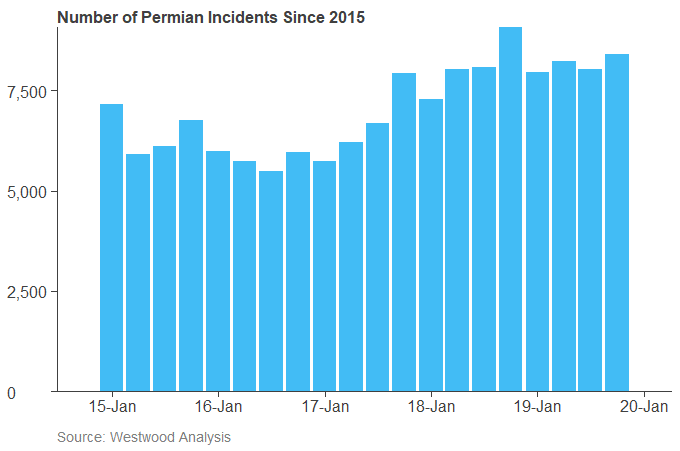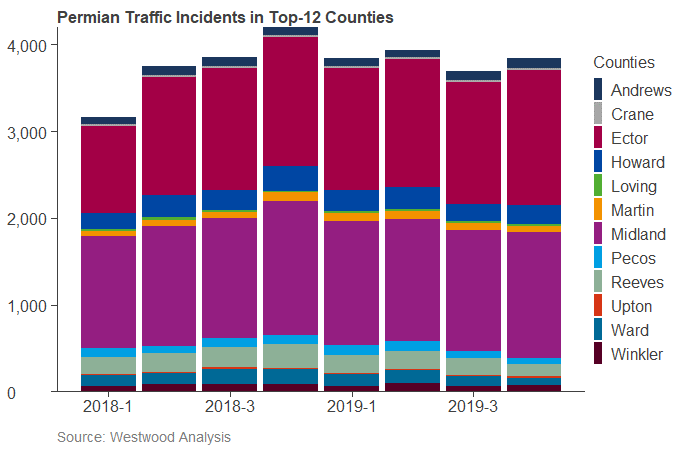Since 2017, the Permian Basin has been the largest supplier of in-basin, or “local sand” in the Lower 48 with a nameplate capacity of 80 million tons of frac sand per year. In three short years, suppliers designed, built, and operationalized over 20 frac sand facilities. The largest three mines have a nameplate capacity of 6 million tons each. Congestion, traffic, and incidents are inevitable with so much activity in the Permian, including sand hauling, water hauling, frac crews, drilling rigs, and other well service providers.
 According to the Texas Department of Transportation, or TxDot, within the 53 counties making up the Permian Basin, over 30,000 traffic accidents were reported in 2019, a 23% increase from 2017, when the first in-basin sand mine became operational.
According to the Texas Department of Transportation, or TxDot, within the 53 counties making up the Permian Basin, over 30,000 traffic accidents were reported in 2019, a 23% increase from 2017, when the first in-basin sand mine became operational.
Traffic Incident Data Illustrates Peak in Q4’18
A closer look at the TxDot data reveals traffic accidents peaked during Q4’18 with over 9,000 reported traffic incidents, a 54% increase from the beginning of 2017. For the top 12 Permian counties, designated by a mine in the area, Ector and Midland counties led the way with a combined total of over 10,000 traffic incidents in 2018 and over 11,000 in 2019. The below chart breaks down reported traffic incidents by quarter for the top Permian counties since 2018.
 Route 285, or what West Texas locals call “death highway,” runs from Pecos, Texas to New Mexico. This one highway ended 2019 with approximately 300 reported accidents, a 32% decline from 2018. The sudden drop-in activity could be contributed to traffic safety programs, completion of road improvement projects and reduced overall activity in the Permian. Either way, a decline in traffic incidents is a positive sign. Another positive reduction in traffic reporting were deaths. Reported fatalities were down 6% in 2019 from the previous year.
Route 285, or what West Texas locals call “death highway,” runs from Pecos, Texas to New Mexico. This one highway ended 2019 with approximately 300 reported accidents, a 32% decline from 2018. The sudden drop-in activity could be contributed to traffic safety programs, completion of road improvement projects and reduced overall activity in the Permian. Either way, a decline in traffic incidents is a positive sign. Another positive reduction in traffic reporting were deaths. Reported fatalities were down 6% in 2019 from the previous year.
Safety Precautions and New Solutions
As we move into Q1’20, we expect oilfield activity to ramp up as well as continued in-basin sand production, which equates to more vehicles on the road. Companies are continuing to present ideas to mitigate the traffic congestion, incidents, and fatalities.
Atlas Sands, a frac sand supplier who owns and operates two mines in the Permian, has proposed to construct a 16-mile covered overland conveyor belt system to deliver sand from West Texas to Southeast New Mexico. If approved and constructed, the Bureau of Land Management, or BLM, estimates, “the overland conveyor system would annually reduce the number of miles driven by sand-hauling trucks on public roadways by approximately 25-million miles, or 47 percent.”. This would have a dramatic effect on road conditions, traffic accidents, overall congestion and emissions. Currently, Atlas Sands’ Kermit facility serves approximately 500 trucks per day.
E&Ps, logistics companies, and sand suppliers are seeking solutions to reduce the number of trucks on the roadway and achieve zero incidents.




